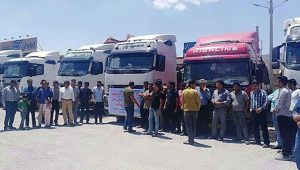
Truck driver’s strike on its 9th day.
On Wednesday, May 30th, the truck drivers’ strike in Iran stretched to its ninth day. Drivers in 257 cities in 31 provinces began their latest strike on May 22nd. The strike has forced the closure of numerous businesses and has led to fuel shortages in urban areas.
Strikes among Iran’s truck drivers have taken place over the last three years, with the first such strike occurring in July 2015, as drivers face increasing frustrations. The truck drivers have cited a number of grievances that led to the current strike. Among their concerns are:
- High taxes;
- Increased levies on transported loads;
- No change in rental fees for three years;
- Increased fees from third-party insurance companies;
- Low rental fees despite high expenditures by drivers;
- Unfair distribution of loads at sea ports;
- Disparities in load tones between common drivers and those with ties to the regime.
Political prisoners in #Iran write a letter supporting the truckers on strike across the country.#IranProtestshttps://t.co/MCezGjhMsw
— People's Mojahedin Organization of Iran (PMOI/MEK) (@Mojahedineng) May 30, 2018
The protests taking place across Iran have clearly demonstrated the people’s dissatisfaction with the current regime and their desire for regime change. As protests and strikes continue across the country, the regime has resorted to using force to respond to their just demands, in further attempts to suppress dissent from the people and prolong their rule.
On Tuesday, May 29th, the National Council of Resistance of Iran (NCRI) reported on the regime’s response to the ongoing uprising currently taking place throughout Iran. The regime has become increasingly alarmed by the anger of the people and the steady stream of protests against the regime and its policies. Khamenei expresses this sense of desperation when he ordered the deployment of armed units to protect state offices and agencies from the people and their escalating protests.
The IRGC news agency reported that Khamenei’s directive for “Establishment of protection units in executive agencies” that was “approved by the Supreme Commander General, was notified to the relevant authorities to be executed.”
According to Fars News Agency, which is affiliated with the Revolutionary Guards, the stated purpose of the directive was “to protect the infrastructure, buildings, facilities, equipment and some of the specialized subject-specific missions of the executive agencies requiring armed protection, with the aim of developing, enhancing and strengthening the security of the mentioned apparatuses through the organization of armed units of executive agencies by the police force and by assigning security and protection to these apparatuses.”
The directive is a repressive measure intended to protect the regime and its institutions from the people it has oppressed with its corruption and brutality. As part of the uprising, protesters in January occupied many government buildings, as well as organs of repression and crime, “theological centers,” and offices of Khamenei’s representatives and “Friday Imams.”
Efforts to suppress protests have largely failed, and the people of Iran are still gathering daily for multiple protests about a variety of issues.
Staff writer
